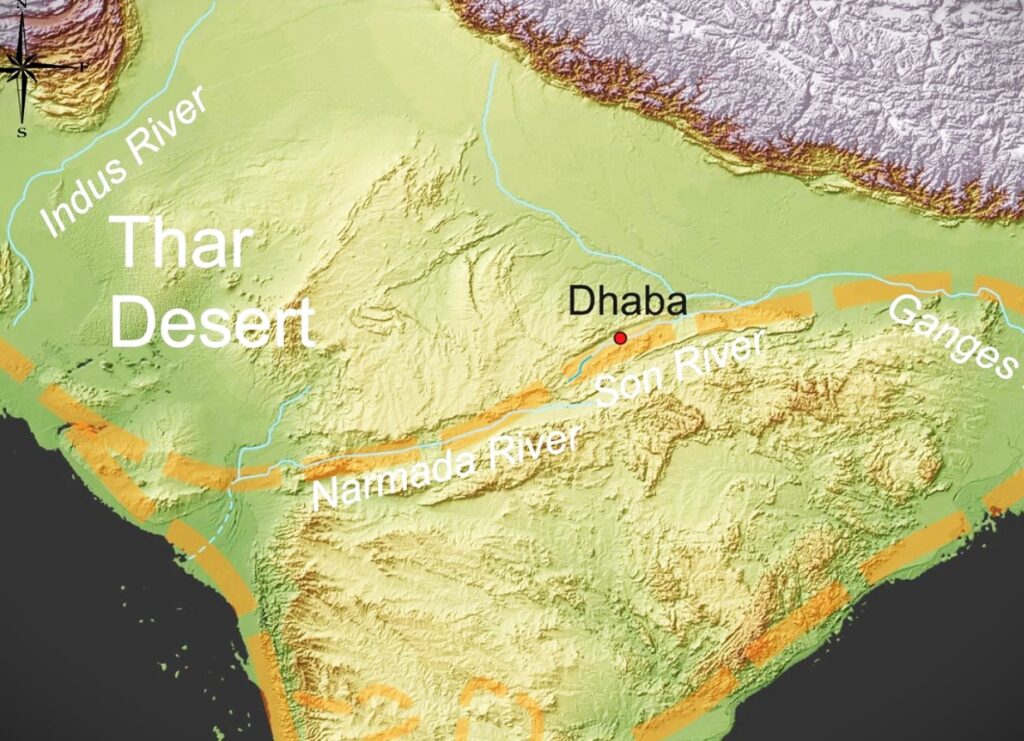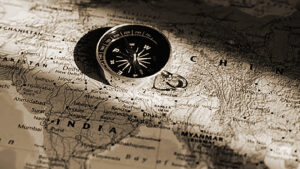The big question: How old is Indian civilization?
September 17, 2023: Did you know that the Indian civilization could be as many as 80,000 years old; that it’s not 5,000 or 6,000 years old, as we have known for centuries? Most Indians aren’t aware of this new revelation, which has been in the public domain for the past three years.
The mainstream media, government honchos, reputed archaeologists and historians, noted writers, updated schoolbooks, university professors, seemingly well-informed research bodies, and influential social media commentators are mostly unaware of this vital piece of information about the origin of Indian civilization.
In February 2020, the world was busy watching news about the coronavirus outbreak in Wuhan with bated breath. It was the season of fear. The virus was the only thing on people’s mind. Naturally, most people didn’t notice what a team of archaeologists found in a little-known forested corner of the central Indian state of Madhya Pradesh.

They found a sizable bunch of ancient stone tools that had been buried deep into the earth under layers of sediment. Upon scrutiny, the artefacts turned out to be between 65,000 and 80,000 years old. The scientists carefully studied the stone tools, and found something that completely changed what we knew about our origins.
The discovery answers the million-dollar question: How old is Indian civilization? The findings proved that human beings have been continuously living in the central Indian region for 80,000 years. So, if people at that time used strategic stone tools and settled down in a specific zone, it means it’s highly likely that they had a distinctive civilization – of course, a basic one. In that case, it would be far older than the Indus Valley Civilization. We know that human settlement along the Indus Valley began around 5,300 years ago.
Dhaba vs. Indus Valley
The precise location where the discovery was made is a place called Dhaba. Dhaba is not thickly populated, and it lies on the Sone river valley of Madhya Pradesh. That area lies to the east of the well-known Narmada river valley.
The human-made artefacts were found at three excavation spots in Dhaba. The discovered stone items spanned a time period of about 55,000 years – from 80,000 years ago to 25,000 years ago.
In the light of the big question – how old is Indian civilization – a general archaeological hunt has been underway across the Sone river valley since 2007. Finally, the breakthrough came three years back. The big discovery was announced in an article published in the science journal, Nature Communications, on February 25, 2020.
The team of scientists that cracked the case included 16 archaeologists. Five of them are Indian – Jagannath Pal, Jinu Koshy, MC Gupta, DP Mishra, and AK Dubey. Pal, Gupta, and Mishra work at the University of Allahabad. Koshy is associated with the University of Madras, and Dubey is attached with Banaras Hindu University. The other scientists are from Australia, Britain, and the US.
The report in the Nature journal reads: “The Dhaba localities provide evidence of long-term human occupation spanning the last 80,000 years. Occupation spans the Toba eruption [which happened 74,000 years ago in Sumatra, Indonesia]. The lithic industry from Dhaba strongly resembles Middle Stone Age stone tool assemblages from Africa, Arabia, and Australia, interpreted here as the product of homo sapiens as they dispersed eastward out of Africa.”
The game-changing discovery came in three steps. First, excavations in Dhaba led to the discovery of the ancient stone tools. Next, the precious items were taken to the archaeology department of the University of Allahabad. Over there, the tools were minutely studied for clues about the past.
After that, they were dispatched to the University of Wollongong in Australia. An advanced scientific process called IRSL dating (infrared-stimulated luminescence dating) was carried out over there. The technique revealed the approximate age of the artefacts. That was the moment when the world of archaeology got to know that the Indian civilization is way older than what we have known for a long time.
How old is Indian civilization? An uncomfortable question
There are two things that should strike you as odd in the context of the revelation. One, there has been scanty coverage by the mainstream media about this major archaeological development. A few paid media outlets covered the announcement, but only as routine news – not as a big discovery, not with prominent headlines. Therefore, no one in Bharat and abroad from all walks of life talk about it. Effectively, the biggest discovery about the origin of Indian civilization almost never happened!
The second thing that’s odd about this whole episode is the way in which the announcement was twisted – perhaps intentionally – to take the attention away from the main discovery.

If you check out the original article that was published in Nature Communications, you will find that the headline doesn’t say that the Indian civilization may have been 80,000 years old. Instead, it talks about something else. It talks about people surviving a major volcanic eruption that happened in Sumatra, Indonesia, about 74,000 years ago. The exact headline is: ‘Human occupation of northern India spans the Toba super-eruption 74,000 years ago.’
As a result of this subtle twist in the presentation of the development, dozens of websites and media outlets around the world reported it only with the volcano angle in their headlines. Most of the news headlines you will find out there don’t say that a discovery has found that the Indian civilization could be 80,000 years old. The relatively more significant outcome is buried under the headlines.
Sadly, it holds true even for popular Indian media outlets that covered the development. Most of them ran headlines talking about the volcanic eruption, not our civilization’s age.
Clearly, this gigantic scientific disclosure has been ignored for some reason. It is not surprising for the Indian mainstream media to miss the plot. They generally cover everything in a shallow way. They don’t go deep into anything that is offered to them on a platter. The original Nature article’s headline focused on the volcanic eruption. So, the Indian media outlets simply reproduced the same angle, ignoring the bigger story.
Western cold shoulder
But why did the popular special-interest organisations of the western world also play down the discovery? They usually take immense pride in their so-called meticulous coverage of significant global events, irrespective of geopolitical compulsions. They claim they go deep into every major global development of high magnitude.
National Geographic, Science magazine, Forbes, Smithsonian magazine, Britannica, Oxford, Cambridge, CNN, BBC, The New York Times – all of them chose to report the discovery only from the narrow perspective of the Toba volcanic eruption. None of them played up the bigger story – that the Indian civilization could be far older than what we knew.
What is the reason behind this strange gap? Is it deliberate and tactical? Is it because the collective West is perhaps not comfortable with the new truth? A truth that shows Indians as a basic civilization are historically much taller than the western civilizations than previously thought. Is this precisely why the question – how old is Indian civilization – remain shrouded in mystery?
Many western so-called scholars agree that the first signs of civilization in South Asia were there about 9,000 years ago. But it appears now they are not comfortable with the actual truth that it was there 80,000 years ago, not 9,000 years ago.
If you look at the larger picture, the West loves to club the following civilizations together as a vague bunch for its own narrative-building convenience: Mesopotamia, Ancient Egypt, Ancient Bharat, Ancient China, Caral-Supe in Peru, and Olmec in Mexico. The West is comfortable with this narrative because it doesn’t place any civilization too far back in time.
Some mainstream archaeologists in the West repeatedly push a theory that says the ancient European civilization began about 57,000 years ago. They say that it started when humans migrated from the Levant region in the eastern Mediterranean to mainland Europe. But then, some other scientists argue that those were only prehistoric cultures and not proper civilizations, such as Azilians, Vincas, and Minoans.
Well, now you know the math. The collective West won’t accept the truth that Indian civilization could be 80,000 years old. Why? Because it dwarfs the accepted belief that European civilization could be 57,000 years old.
The powerful elite class of the western world has this perpetual obsession about never losing the civilizational race to the eastern world societies. When uncivilized British invaders physically occupied South Asia for 200 years, they made it look like they were here to civilize the Indians.
Similarly, if you follow what presidents and prime ministers of interventionist countries such as America, Britain, Canada, and France say today in their speeches, you will find a tone of snobbery and condescension. Sadly, the whole narrative about human civilization is controlled by the West. Hence, the discovery in Dhaba in Madhya Pradesh will remain largely untold all over the world.
Why are Indians downplaying it?
While it is understandable that foreign forces will try to play down this episode since it is not in their interest, why are Indians themselves also playing the same game? What is stopping our own authorities from telling all Indians about this major discovery? Why aren’t we calling upon domestic sources of information to take up the matter, and once and for all, seek to settle the question: How old is Indian civilization?
Forget the Indian mainstream press. They just repeat the narrative that is manufactured by the western media. But what about our own so-called nationalists? Our own educators. Our own writers, historians, colleges, and social media celebrities? What is really stopping them from sharing this powerful story among our citizens?
Imagine that this same discovery is made somewhere in California or near Oxford or in France. For sure, the West will turn it into a media carnival. It will be the only thing in the news headlines. The West knows the art of making a huge show of the smallest achievement. Why can’t we in Bharat turn up the volume on this genuine development? Why can’t we look at the question – ‘How old is Indian civilization’ – from this whole new perspective?
Is something really wrong with our sense of pride and self-belief? Bharat is nowadays swept with talk of nationalism and love for our motherland, our history. Where is all that pride when it comes to something really significant such as the discovery in Dhaba? As Indians, we need to look into the mirror, look hard, and ask these probing questions. Questions about our own sense of self-respect and dignity.
REPUBLISHING TERMS:
All rights to this content are reserved. If you want to republish this content in any form, in part or in full, please contact us at writetoempirediaries@gmail.com.










